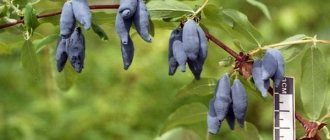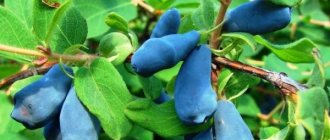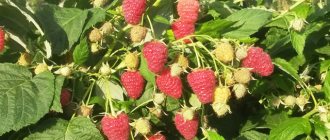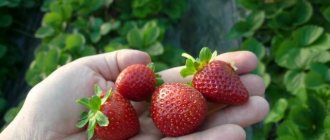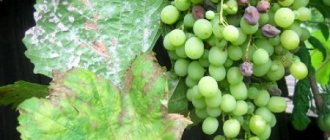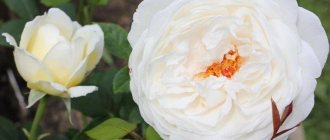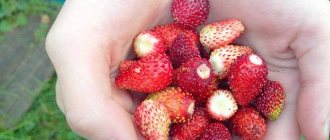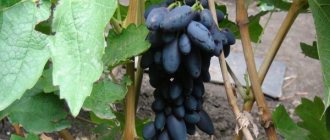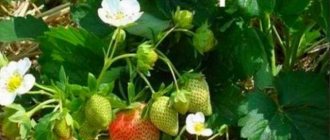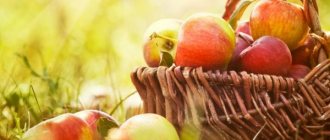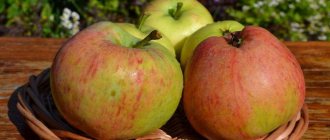Description and characteristics of the variety
The honeysuckle bush Pride of Bakchar has a pronounced spherical shape. The branches grow chaotically, leaning down and reaching towards the sun. From a distance the bush resembles a small stack of mown grass. The branches are thin, but very strong and flexible. The height of the bush reaches 1.5 m, width – 1.2 m.
Attention! The bush is not decorative, so the variety is not suitable for decorating a site.
The honeysuckle variety is characterized by resistance to diseases. The bushes tolerate bad weather conditions. According to reviews from gardeners in the Moscow region, the crop brings a good harvest. Fruiting is extended. The variety is medium late in terms of ripening. The ripening of the first fruits begins in the third decade of July.
History of the variety's creation
The history of selection of varieties of Bakchar honeysuckle is closely connected with the development of the nursery of the same name at the Siberian Research Institute, located in Tomsk. Back in 1934, work began to study the possibility of growing fruit and berry garden crops in the harsh conditions of the Siberian taiga and marshy soils. Short summers, cold springs, long winters - in such harsh climatic conditions, breeders developed new varieties of garden crops. The main direction of scientific research was the development of a new berry crop at that time - honeysuckle. Over the years, more than two dozen new varieties of this amazing garden crop, adapted to the harsh conditions of Siberia, have been developed. One of their main achievements was the breeding of Bakchar's Pride, a honeysuckle with an excellent description of the variety.
Delicious harvest of honeysuckle Pride of Bakchar - dark blue berries with a harmonious taste of sweetness and delicate bitterness, filled with strawberry aroma
Features of fruiting
Among large-fruited honeysuckle varieties, Pride Bakchara occupies a leading position. The fruit weighs 1.3 g. The shape of the berry is elongated to 4.5 cm and resembles a curved spindle. The purple skin is rough. The top of the berry is covered with a silvery-white coating. The harvested crop is subject to long-term storage and transportation. The berries do not tend to crack.
The dense fibrous pulp is moderately rich in juice, but the taste is delicate and dessert-like. There is no bitter taste. The pulp has a perfectly balanced balance of sugar and acid. In terms of taste, the berry received a tasting score of 4.8 points. However, this variety of honeysuckle has one peculiarity: if grown improperly, the fruit is still capable of accumulating a slight bitterness.
Full fruiting of the bush begins at the age of five. Honeysuckle can bear up to 1.5 kg of fruit. Every year the yield increases. The peak of fruiting is observed in an eight-year-old bush. Honeysuckle of the Pride Bakchar variety at this age is capable of producing from 2.5 to 4 kg of berries.
Another feature of the crop is the average fruit shedding. Moreover, only ripe berries fall off, while unripe fruits remain hanging on the branches. Thanks to this feature, gardeners have found a quick way to harvest. They spread any material under the bush and shake the branches.
Honeysuckle berries are universal in purpose. The fruits of the Pride Bakchar variety are used for jam and freezing, but the full composition of vitamins is preserved in the fresh pulp. Honeysuckle is beneficial if eaten fresh.
The video talks about the blue honeysuckle variety Pride Bakchara:
Honeysuckle variety Pride of Bakchar
Among the new types of fruit berries that have been gaining popularity in recent decades, one of the leaders is honeysuckle. This crop is especially important for countries and regions with cold climates in which traditional fruit trees do not develop well. Honeysuckle is often not inferior to them in taste, and in terms of its beneficial properties it can even give them a head start! Now we will get acquainted with one of the many varieties of this interesting berry.
History of creation
Pride Bakchar was bred in the famous nursery of the Tomsk region “Bakcharskoe”. Perhaps this is the most famous place in Russia, where they do a lot of honeysuckle culture. In any case, the Bakchar experimental plantation planted with this berry has no equal in area in the country!
The variety was submitted for approval in 2002, and four years later it was entered into the State Register. Thus, it can be considered relatively young, even taking into account that serious work on honeysuckle varieties began only in the middle of the last century.
Description of the appearance of the plant
The bush is medium-sized, has a spreading, wide shape. Typically, the height of mature specimens reaches 1.6 meters, with a width of about one and a half meters. The shoots are long, with light bark, often drooping towards the ground. The peculiarity is that some of the shoots rush upward, and the general impression of the bush is a slight sloppiness, an “uncombed” shape.
The branches are practically devoid of the pubescence characteristic of the crop; it is present only on the leaves. The leaf blade is medium-sized, matte, leathery, dark green in color.
The pride of our hero is his berries! They are unusually large in size: about 5.5 cm in length and 1.5 cm in diameter. The average weight of an individual berry is from 2 to 3 grams. Rare honeysuckles can compete with Bakchar's Pride in this indicator.
The ripening of the crop occurs in the second half of July, so the variety is classified as a mid-late or even late variety. The berries, upon reaching ripeness, quickly fall off; they need to be collected regularly and on time. Perhaps this is the biggest drawback of the variety.
The second drawback, albeit a small one, is a noticeable bitterness in the taste, although the ripe fruit is generally pleasant, sweet and sour. But the berry has an attractive appearance: violet-blue, with a noble whitish coating, large and smooth! From each bush you can collect from 3 to 4 kg of fruit. It is noteworthy that they are quite lightweight, with good transportability, which is actually rare for honeysuckles. For this reason, the variety is considered valuable for industrial cultivation.
Features of agricultural technology and use
To some extent, we have already covered these issues. Regarding care features, you can add the following:
- In general, the culture is resistant to adverse factors and diseases. It is characterized by increased frost resistance. This applies even to blossoming flowers, which are not afraid of serious return frosts.
- For pollination, other varieties are required, among which Bakcharsky Giant, Daughter of the Giant, and Delight are preferable.
- The harvest can be harvested not only manually, but also mechanically.
- It loves space and light, so bushes should be planted at a distance of at least one and a half meters, or even a little more.
- This honeysuckle loves regular watering and does not develop well on very light sandy soils, as well as on excessively dense, clayey soils.
- It is advisable to regularly loosen and mulch the tree trunk circle, especially in more southern, drier regions.
The berries have a dessert purpose and are often consumed fresh in private households. They also serve as an excellent raw material for preserves, jams and juices, as a material for homemade wine. Pride of Bakchar is not used for decorative purposes due to the features of the crown discussed above.
Advantages and disadvantages
To make it easier for a gardener to decide whether the Pride of Bakchar variety is needed on the site, you need to know its positive and negative qualities.
The advantages include the following:
- resistance of bushes to bad weather conditions;
- in the event of return frosts, the bush can withstand down to –8°C;
- large fruits with good taste;
- the crop can be stored and transported;
- unpretentiousness of the plant in care;
- the crop is rarely exposed to diseases.
One of the disadvantages of the variety of honeysuckle Pride of Bakchar is the shedding of berries. If you do not harvest the crop in a timely manner or forget to spread a cloth under the bush, the fruits will fall to the ground and disappear.
Advantages and disadvantages
The honeysuckle bush “Pride of Bakchar”, unfortunately, cannot be called decorative, so it will not decorate the landscape of the site, but it pleases with a good harvest, which can be used to make preserves, jellies and other dessert dishes. Even after freezing, most of the nutrients remain in the berries and their characteristic taste is preserved.
Among the advantages of this variety, it makes sense to highlight the following:
- the plant has large fruits;
- the berries are stored for a long time and are not damaged during transportation;
- honeysuckle is tasty and healthy, which is due to its rich composition, including plant acids, vitamins, natural flavonoids, and many trace elements;
- it is convenient to harvest, and this can be done in several stages, since the crop has a long fruiting period;
- the variety is immune to pests, diseases, and fairly low temperatures (down to -8 degrees).
There are also disadvantages, but they are much fewer than the advantages of cultivating honeysuckle. First of all, this is self-sterility, which will require additional planting of other varieties, the main ones of which are “Bakcharsky Velikan”, “Strezhevchanka”, “Vostorg”. Other disadvantages are the shedding of ripe berries, which requires timely collection, and the chaotically spreading crown.
Secrets of cultivation
There are no special secrets in growing blue honeysuckle Pride of Bakchar. There are only nuances characteristic of the variety.
Landing dates
Honeysuckle seedlings can be planted in spring and autumn. In summer, layering is done from an adult bush. When planting in spring, seedlings must be planted before the buds open. May - it's already late. At this time, the bush rapidly begins to develop shoots. The optimal planting time is autumn. Honeysuckle seedlings begin to be planted from September to the third ten days of October.
Selection of location and soil
Honeysuckle is an unpretentious plant, but to obtain a good yield, you need to choose a place on the site that is comfortable for the bushes and prepare the soil. Select a site taking into account the following rules:
- protection from drafts, but good ventilation of the area is desirable;
- the height of the groundwater layers is not higher than 1 m;
- the soil is not acidic, more neutral, constantly moist and preferably without large admixtures of sand.
It is optimal to arrange the honeysuckle bushes of the Pride of Bakchara variety so that the crown is illuminated by the sun. Roots love shade. It is usually formed due to a wide crown.
Planting a bush
Planting honeysuckle seedlings is carried out in the following order:
- Since honeysuckle must be grown in pairs with pollinators, markings are made to locate the bushes on the site. The average distance between plants is 1.5 m.
- The holes are formed with a depth of 40 cm. The diameter of the hole is sufficient within 50 cm.
- Each hole should be filled with a fruitful mixture. To do this, pour a bucket of compost, 0.5–1 kg of wood ash into the hole and add 25 g of superphosphate. At the bottom, under the fertile mixture, a drainage layer of stones must be poured. Pour at least 1 bucket of warm water into the hole.
- By the time the seedling is planted, the water should be absorbed and the soil should settle. At the bottom of the hole, a small mound is formed from black soil. The honeysuckle seedling is placed on a hill, the root system is straightened and covered with loose soil, deepening the root collar no more than 2 cm.
The planted plant is watered abundantly with water at room temperature. Mulch is scattered around the trunk.
Reviews
Margarita bought a seedling of this variety at an exhibition in Tomsk back in 2009. I started harvesting good harvests in 2015, and I was very surprised by the difference! Just think, in one season honeysuckle produced 1.5 kilograms of berries, and the next summer almost 4. The taste is excellent, sweet with a refreshing, pleasant sourness, we eat fresh fruits, dry them, freeze them and make jam.
Ruslan Variety does not require constant monitoring, which is very important for summer residents who do not often visit the site. Although, during the ripening period of the berries, you still have to monitor the bushes. If you choose the right place, there is no excess acid or bitterness in the berries, it’s been tested! The first growing experience was unsuccessful; out of ignorance I chose a slightly shaded place. I think Bakchar's pride is one of the best varieties of honeysuckle.
Sources:
https://sortoved.ru/zhimolost/sort-zhimolosti-gordost-bakchara.html https://eda-land.ru/zhimolost/gordost-bakchara/ https://sveklon.ru/zhimolost-gordost-bakchara
Care
Honeysuckle Pride of Bakchar does not require special care. The gardener only needs to water, feed the bushes, prune and remove weeds in a timely manner. It is important to pay attention to the prevention of pests and diseases.
Watering
The variety Pride Bakchara is moisture-loving, like most other honeysuckle. Increased watering is needed during flowering and when berries are filling. In dry summers, at least 3 buckets of water are poured under each bush. After watering, it is advisable to mulch the soil to retain moisture.
Advice! In early spring, before the buds open, honeysuckle bushes are watered with hot water heated to a temperature of 60°C. The procedure destroys wintering pests, fungal spores and promotes the awakening of the kidneys.
Top dressing
After planting a seedling for two years, honeysuckle does not need feeding. In the third year, they begin to add organic matter to the bushes. The best time for feeding is early spring before the buds begin to awaken and autumn after harvesting. During the flowering period, mineral complexes are added to each bush.
Fertilizers should contain potassium, nitrogen and phosphorus. Complex preparations are applied dry or dissolved in water. Root feeding is allowed, as well as spraying the bush. In the second option, a urea solution is usually used. With the beginning of the ovary, honeysuckle must be fed with ash.
Trimming
Sanitary pruning of honeysuckle variety Pride Bakchara is done every spring. Dry and damaged branches are removed from the bushes. If there are elongated weak shoots, they are also cut off with pruning shears.
Honeysuckle bushes begin to rejuvenate at the age of six. Old spent branches are cut off at the root. A new bush is formed from five powerful shoots, and all remaining shoots are cut off.
Protection from diseases and pests
The variety Pride Bakchara is considered resistant to diseases and pests, but prevention should not be forgotten.
Honeysuckle has the following enemies:
- The scale insect feeds on the sap of the plant. If you don't fight it, the bush will dry out. For prevention, honeysuckle is sprayed with Rogor. Do a double treatment, leaving 10 days between treatments.
- Caterpillars destroy foliage. A small number of individuals are collected by hand. In case of severe invasion, honeysuckle bushes are sprayed with a solution of the drug Inta-Vir.
- Aphids are difficult to see, but can be easily recognized by their yellowing, curled leaves. To treat the plant, the drug Confidor or Rogor is used.
- When ticks appear, the foliage also curls, but becomes brown with a large number of small holes. Honeysuckle bushes are saved by treating them with Mavrik or Tedion.
- Fungal infection of the plant is accompanied by rot. In damp hot summers, it is necessary to carry out preventive spraying of the bush with a solution of 10 liters of water, 1 tbsp. l. washing soap shavings, 10 g copper sulfate powder.
Any disease is easier to prevent than to cure. It is better to carry out preventive spraying of bushes before symptoms appear.
Reproduction
Honeysuckle is propagated in several ways. The most difficult option is with seeds. Typically, gardeners prefer dividing the bush, layering and cuttings, or simply buying a seedling.
Reproduction of honeysuckle by dividing the bush allows you to get a full-fledged plant the next year. For division, choose strong young bushes 3–4 years old. The plant is dug up and divided into several parts so that each branch has a full-fledged root. Each seedling is planted in a hole.
Attention! You can divide the bush in the spring before the buds open or in the fall after the leaves fall.
Honeysuckle variety Pride Bakchara is propagated by layering in June. The soil near the adult plant is loosened. Several lashes from young growth are bent, pressed into the ground to a depth of 4 cm, and then fixed with pieces of wire. To speed up root growth, you can make an incision in the bark with a knife. The buried lashes will become full-fledged seedlings next year. In the spring they are cut off from the bush and planted in holes.
Important! A shrub will form from the cuttings only in the third year.
Honeysuckle is propagated by green cuttings after flowering has ended. A young branch is cut with scissors. Cuttings 10 cm long are cut from it. Leaves are removed from the lower part and placed in a growth stimulator for a day. The next day, the cuttings are immersed in damp soil and covered with a jar on top. The procedure is performed in the third ten days of May.
In the fall, you can prepare lignified cuttings. In winter, they are stored in any container with sand or sawdust, first wrapped in cloth. In spring, cuttings are planted in the ground at an angle of 45°. Only two buds are left above ground level.
Harvesting and transportation, keeping quality of berries
Harvesting of this variety is mid-late, starting around mid-July. The fruits are easy to transport due to their very thick skin. Keeps in the refrigerator for up to 7 days. Large sweet berries can be eaten fresh, or they can be dried, frozen, prepared in the form of jam, raw jams, compotes, infusions, decoctions, and even homemade wine.
Honeysuckle berries will help you compensate for the lack of vitamins and microelements. One cannot fail to mention their medicinal properties. They have diuretic, choleretic, anti-inflammatory and disinfectant properties. Also, consuming honeysuckle is useful for strengthening the cardiovascular system and has a good effect on the overall tone of the body.
Honeysuckle Pride of Bakchar has gained popularity and good reviews from gardeners. Thanks to the ease of care, unpretentiousness, and versatility of dessert berries, this variety will take its rightful place in your country plot.
Benefits and harms
The benefits of edible berries are obvious. They contain a large amount of vitamins. Honeysuckle is considered a medicinal plant; it does not lose its properties when heated.
BENEFIT:
- Used to treat and prevent scurvy
- Boosts immunity
- Reduces high blood pressure
- Helps with migraines
- Strengthens the cardiovascular system
- Removes salts from the body
- Honeysuckle is recommended for gastritis, ulcers
- Treats sore throat
HARM:
- Excessive consumption can cause allergic reactions and intestinal upset. As in any other case.
- When consuming the product, you need to know when to stop and not overeat.

